Videos are highly engaging and capture much more attention than any other type of content. If you aren’t making them, you’re watching them. And, in the case of particularly captivating videos, you want to share them.
Learning how to send a video through email is essential, as it’s one of the most popular communication channels.
Keep reading to learn the exact steps for sending videos (even larger ones) via email using different mailbox providers and tools.
TLDR: Most email clients (like Gmail or Yahoo!) let you insert a link to your video or add it as an attachment. To add a video as an attachment, look for a button that looks like a paperclip 📎. Note that this solution typically has a limitation and can only be used for smaller files.
Sending a video through email to your newsletter subscribers
Attaching a video to your email newsletter makes it more engaging and memorable.
The following data from the Email Marketing Benchmarks report backs this up:
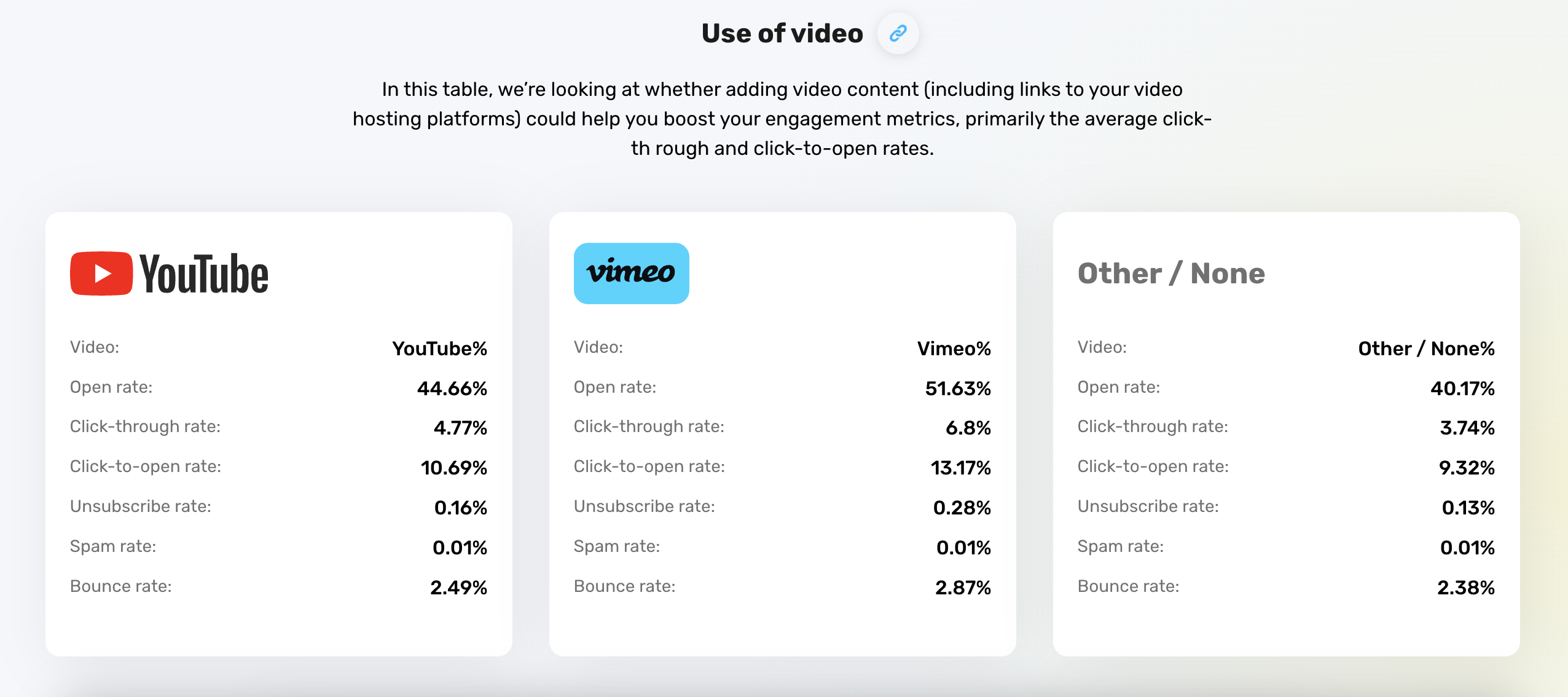
Subscribers are more likely to watch a video than to read a long newsletter or extended article.
You can embed a video or make a thumbnail/image/GIF of a video inside an email and add a link redirecting to an external site, perhaps your landing page, YouTube, or some other medium where they can watch your full video.
Here’s a step-by-step process of how to send videos through email to your subscribers:
1. Upload the video on YouTube (or any other channel you prefer)
Host the file on a video hosting platform before sending it to your subscribers via email. There are several channels through which you can share your videos, but for the purpose of this guide, we’ll show you how to host your videos on YouTube and then email them to your subscribers.
Go to YouTube, and click “Upload video” at the top-right corner of the page.
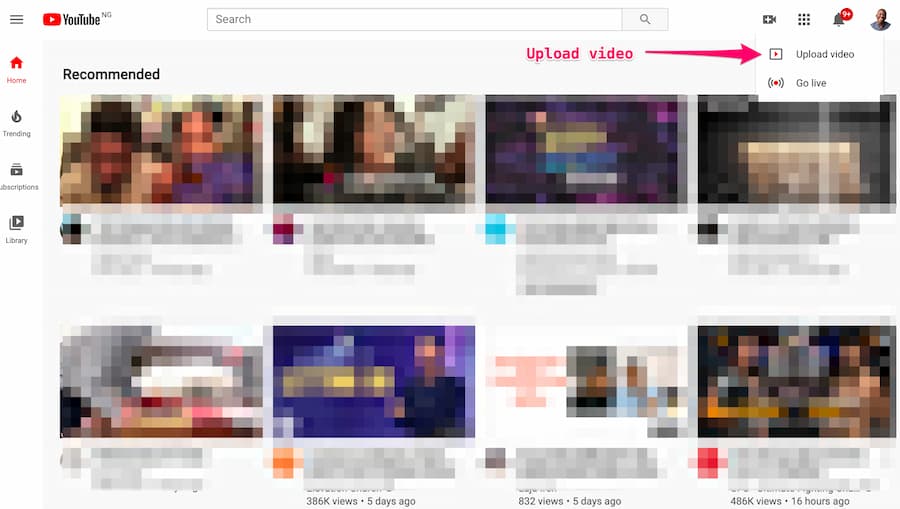
Next, choose the video file you want to upload and click on “SELECT FILE” to upload.
You’ll be able to view the upload progress on a status bar on the screen. Once the video is uploaded, add descriptions and tags to your video.
Then, YouTube generates three choices of thumbnail images for you to use as the feature image for your video. The thumbnail is the first thing your subscribers will see in your email newsletter, so it has to be an eye-catching image.
You can create a custom thumbnail if you already have a verified profile and don’t like any of the YouTube auto-generated thumbnail options. The recommended size for these images is 1280×720 pixels.
To upload your thumbnail, click the “Custom thumbnail” button.
Now that you’ve successfully uploaded your video, you can go to your YouTube page to access the video. Your video now has a unique URL, which you’ll need for the next step.
2. Create your email and import a thumbnail or screenshot into the email
Write your newsletter’s copy using solid advice from copywriters and then embed the thumbnail/screenshot of the video into the body of the email, as seen below.
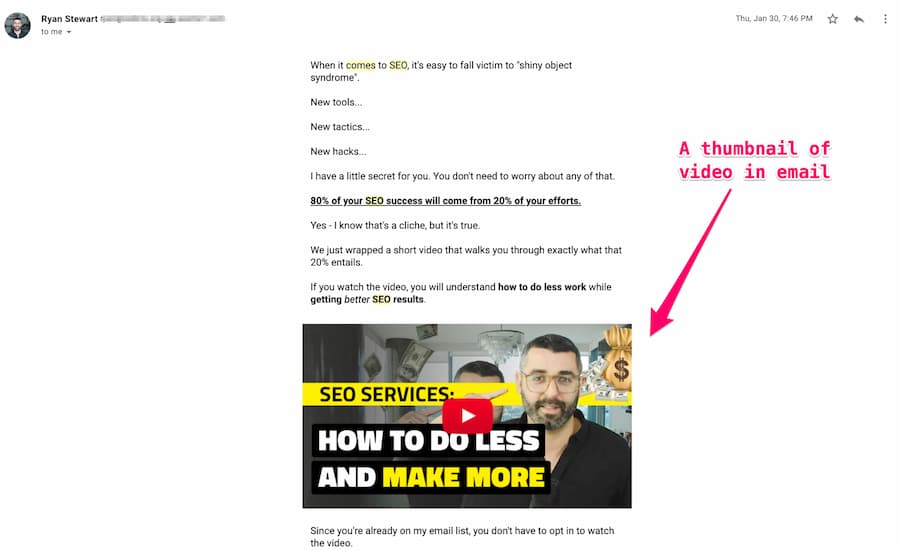
You could make the placeholder a GIF, too. This works even better than a still picture to encourage high engagement rates.
GIF thumbnails often work better than images in emails because they give your subscribers a better feel of what your video is about, increasing the chances they’ll click to watch it.
3. Make the image clickable
You need to make your thumbnail GIF or image clickable so that when subscribers click on it, they’re taken straight to your video.
Check if your email service provider has a functionality that lets you do this. For example, when sending your email through GetResponse, you can include a link to your video in your thumbnail image or GIF.
(Tip: In GetResponse, you can also embed a YouTube video with no need for a placeholder – for a quick tutorial, skip to the section “How to send videos in emails with GetResponse” at the end)
4. Send out a test email
After completing steps #1 to #3 above, you can send a test email to yourself to make sure that everything works as it should. This is basically the same process as sending the email to your mailing list; just send the email to your personal email address first and ensure everything works properly, and you’re good to go.
How to send a video through email to one or a few recipients (Gmail, Outlook, Yahoo Mail)
Sometimes you want to send your video to one or a couple of people, not an email list of hundreds or thousands of subscribers.
And when it comes to sending videos to a few recipients, you can use any of the popular email platforms (for example, Yahoo, Gmail & Outlook) to send your video.
Each email platform works differently, but most of them can help you send videos.
In this section, we’ll be exploring how to send videos via three popular mailing channels:
- Gmail
- Outlook
- Yahoo Mail
How to send a video using Gmail
Gmail is one of the most popular email platforms today.
You have two options for sending a video via Gmail:
- attach a video file from your Google Drive
- or attach a video file from the device you’re using to send your email.
In both cases, Gmail will automatically convert your video (if it’s over 25 MB) to a Google Drive link when you try to upload it as an attachment.
See how these two methods work below:
1. Send the video as an email attachment

First, open your Gmail account.
Second, click the “Compose” button to create a new email.
Next, select “Attach files” (a little paperclip) and choose the video you want to send and click “Open.”
After attaching your video, type the content of your email and click “Send.”
2. Send the video as a Google Drive attachment
Open your Gmail account and click the “Compose” button to compose your email.
Next, click on the “Google Drive” symbol at the bottom toolbar of the email.
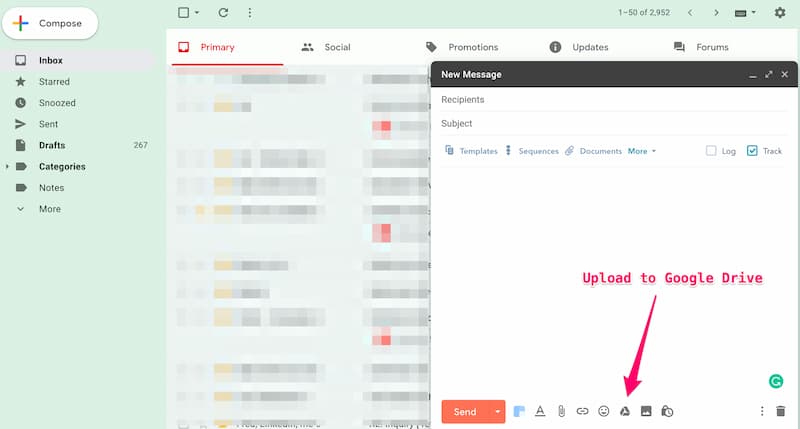
Finally, select the video you want to send and hit “Attachment.”
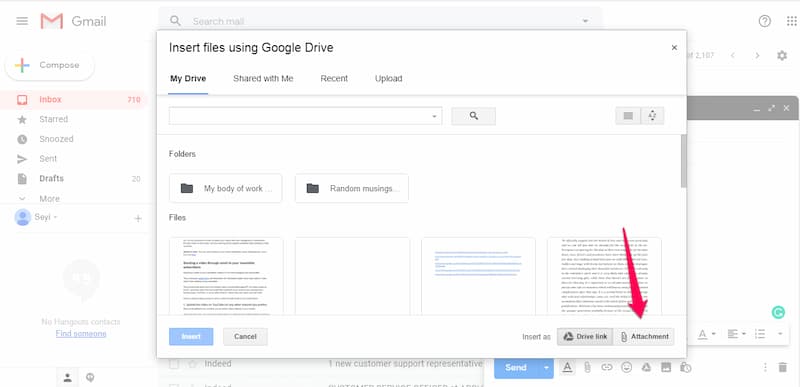
Your video is ready to be sent.
Read more on the blog:
How to send a video using Yahoo Mail
With a Yahoo account, it’s very easy to share your or other people’s interesting videos with friends or colleagues by including them in an email.
There are two main ways you can send videos using Yahoo. You can either share the video links in an email or send the video as an attachment.
1. Share the link (if it’s already hosted online)
When you want to share a video from YouTube or any other social app, you can just share it using its link.
To do this, open your Yahoo Mail account and click on the “Compose” tab to create a new message. Then paste the web link/URL of the video you wish to send in the “Link” tab at the bottom of the screen and hit “Save.” Then compose the message and send it.
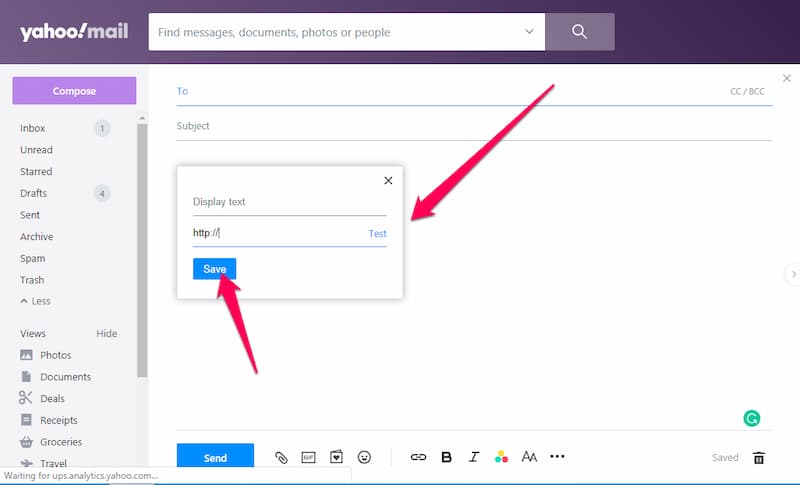
That’s all it takes.
2. Send the video as an attachment
When doing this, remember that you can’t attach files larger than 25MB on Yahoo. It’s best to compress large video files before sending them as attachments. Compressing videos is a pretty simple and easy process, which we’ll go into in detail later in the article.
To send your video as an attachment, open your Yahoo Mail account. Click the “Compose” tab to compose a new message.
Next, click on “Attach files.” A series of options automatically pops up. Click on “Attach files from computer” and choose the desired video files. After this, you can send your email.
You can send as many videos as you want if they don’t exceed the limit.
How to send a video using Outlook
The process of sending videos with Outlook isn’t as complex as you might expect.
It’s similar to the process employed by Yahoo Mail or Gmail and takes little more than a few seconds to accomplish.
With Outlook, you have two options when sending videos via email. You could either send your video:
- As a link
- Or add the video to Outlook by inserting it as an attachment.
1. Send a video in Outlook emails by sending it as a link
The process of sending videos through Outlook is fairly easy.
Just follow these steps:
Click on “New message” and insert the web link or URL of the video you want to send. Do this by clicking on the ellipsis (three dots), where you will find the “More formatting options” tab.
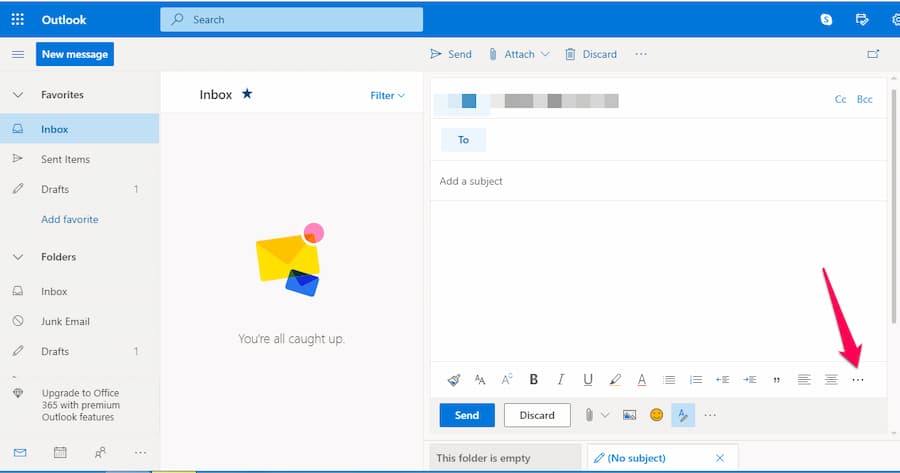
Then click on “Insert hyperlink,” paste the link, and click “OK.”
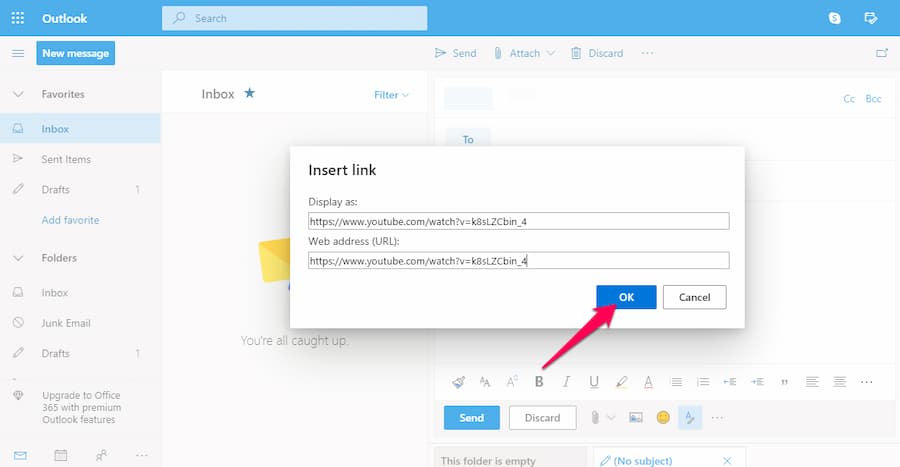
With this, your email is ready to be sent, and your video is safely linked.
2. Add video to Outlook emails by inserting it as an attachment
Take note that Outlook’s maximum attachment file size restrictions are 20 MB rendering most video files too large to send via email attachment. The linking procedure in option one would be better if you’re sending a large video file.
For compressed files or small video files, however, simply click on the “Attach” option, go to “Browse this computer,” select your video and upload it.
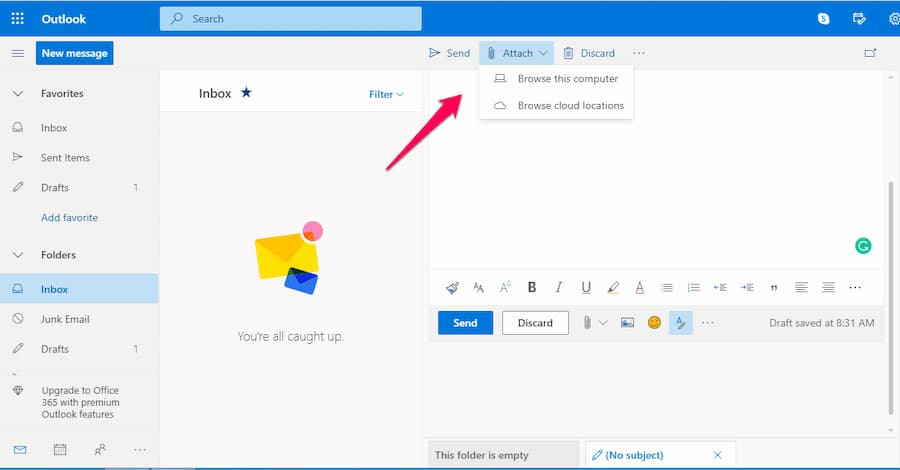
Now you can compose the body of the email and send it.
Is it possible to compress a video to send through email?
Unarguably, the greatest disadvantage associated with videos is their enormous file size.
Longer, higher-definition videos result in larger file sizes. This makes it difficult to attach them to emails.
So how do you send a large video file via email?
There are three main ways.
- You can compress them into a zip file.
- You can make the video shorter and smaller with iMovie on Mac.
- You can send large video files using a cloud storage service like Google Drive, OneDrive, Dropbox, or WeTransfer.
Let’s go by them one by one.
1. Create a zip file
One of the most common ways to compress a video is to compress it into a zip file.
The file reduces in size, and the quality isn’t affected. This option is available for both Mac and PC users.
First, right-click on the video file you want to send if you’re a Windows user.
Then, click on “Send to” and “Compressed (zipped) folder.”
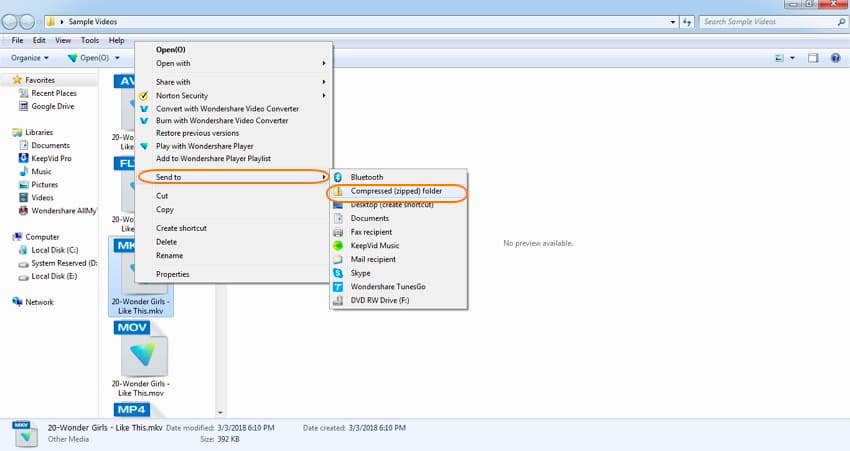
For Mac users, choose “Compress [name],” and the file automatically compresses.
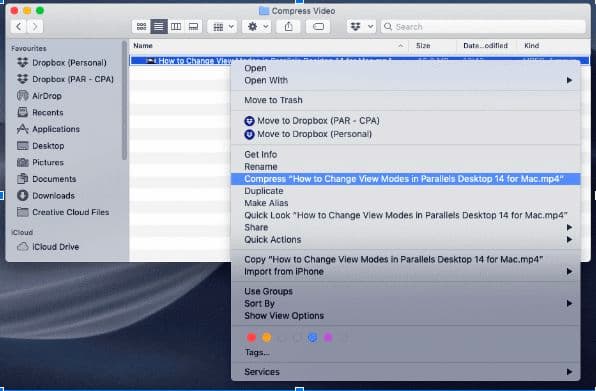
2. Make the video shorter and smaller with iMovie on Mac
Mac devices often come with iMovie, an Apple-enabled movie editing tool.
With iMovie, you can make your video shorter by sending only the important bits. This will decrease the size of the file. You can also use the email option included in iMovie to send the video via email to whomever you want.
The process is pretty simple. Just open iMovie and click on the arrow in the top left corner of the menu bar.
Select the portion of the video you want to send. Then export it by clicking “File-Share- Email.” Lastly, choose “small” to reduce the file size.
Your video is ready to be shared via email. iMovie will open a blank email with the smaller file ready to send.
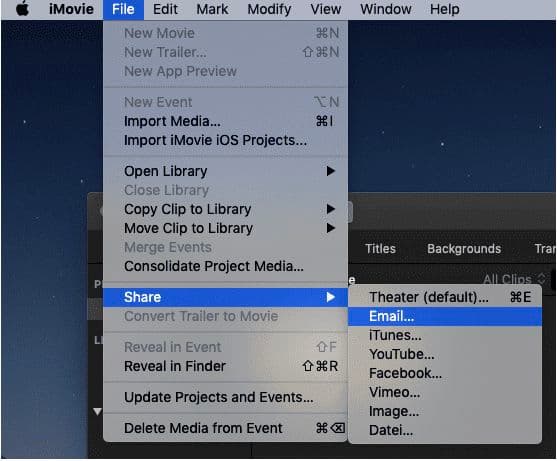
3. Use a cloud service
OneDrive, Dropbox, and Google Drive are here to make life easier for everyone.
These platforms are most likely the smoothest way to send large video files without altering their quality. On Dropbox, all you have to do is upload the video to a shared Dropbox folder, which gives everyone who has access to the folder access to the video as well.
With Google Drive, you upload a video file to your drive and share a link to the file with anyone you want. Dropbox and Google Drive also give you the option to share links to the video file via email with friends and family. It’s that easy.
Of course, there are also other services like WeTransfer. There, you’ll need to upload your file and provide the email address of the person you want to notify that your video can be downloaded.
Be cautious, though, your WeTransfer download link will automatically expire after two weeks if you use their free account.
Reasons you might be unable to email a video
Even in the best of worlds, you may occasionally face some difficulty when sending videos via email – usually when you try to send large video files without compressing them first.
A common occurrence is that your video surpasses the limit for whatever emailing platform you use.
Yahoo Mail and Gmail have a 25 MB file size limit, while Outlook has a 20 MB file size clause. You’ll have difficulty sending videos if they’re larger than the set limits. Also, there are times when system glitches occur. At times like this, you will probably notice that you’re not the only one experiencing problems, and it usually clears up after a while.
The best way to ensure that you’re always able to send your videos without any problems is to first compress them or upload them on a cloud service or social media platform so you can just send out links.
How to send videos in emails with GetResponse
If you use GetResponse for your email marketing, embedding a video into the email’s design is super easy.
When you find a place where your video would fit best simply drag and drop a “Video” block into the layout:
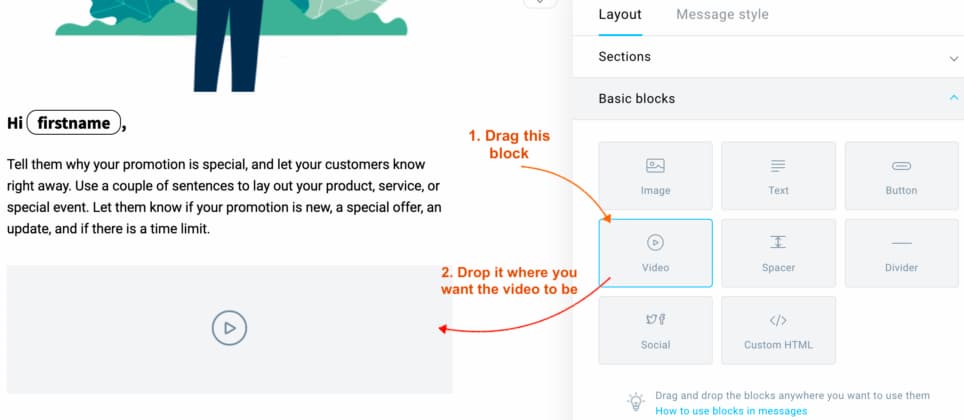
Then, enter the video’s URL. It can be hosted either on YouTube or Vimeo.
Once you’ve entered the URL, the video automatically uploads itself into the email, and options for customization pop up.
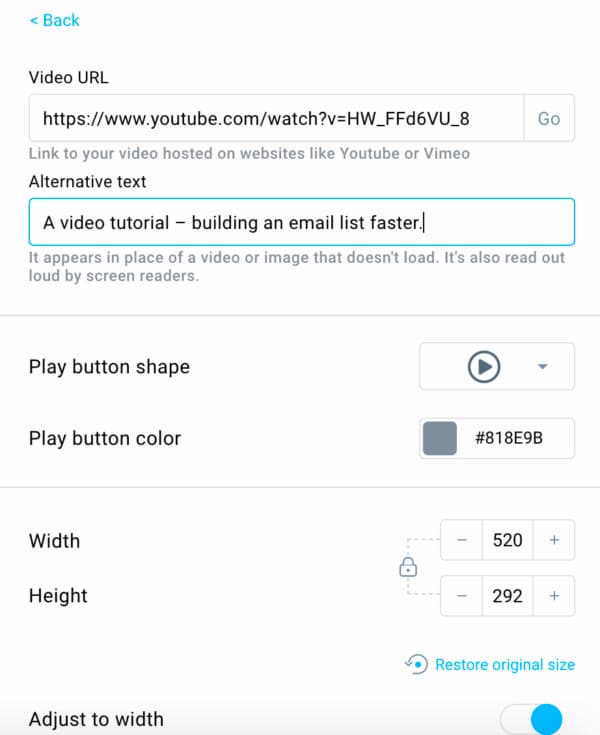
You should always add alternative text to your videos (and images). It appears in place of the video (or image) when it doesn’t load. Write a simple sentence describing what the video is.
Pro tip: Add a full stop at the end of the Alt Text so that a screen reader would know when to pause after reading it out loud.
You can adjust the play button’s shape and color to fit your email template’s overall design. There are also many more customization options you can tweak, for example, width, padding, and alignment. You can also hide the video on mobile devices so that only desktop users can see it.
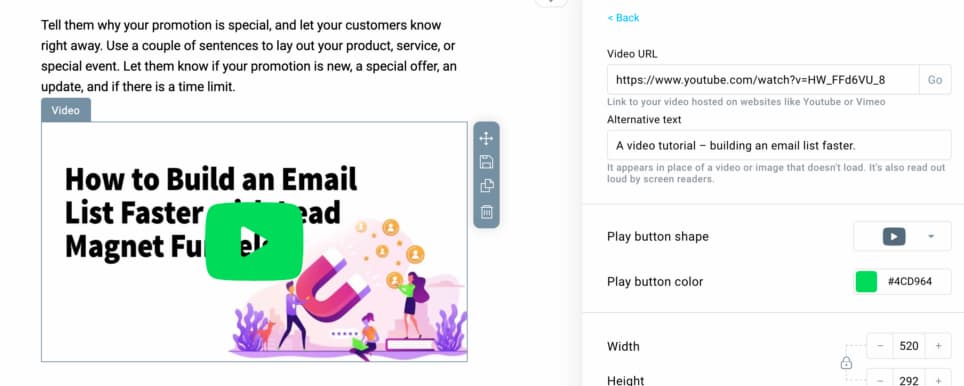
And voila! The video is embedded into your email.
You can now send the newsletter and let your contact list enjoy the amazing video email you’ve just created. You’ll see the engagement rates going up in no time!
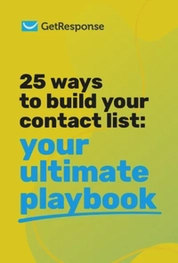
25 ways to build your contact list
We’ve compiled a list of 25 tried-and-tested tactics for the success of your future campaigns.
Conclusion
Now that you know all the possible ways of sending videos via email, I bet you can’t wait to start. Remember, the best way to send videos via email while retaining their quality is the one that works for you ;).
For businesses, freelancers, and consultants, the best way to send videos via email is to embed a YouTube video in an email creator. You can easily do this with the email marketing company GetResponse – get your free account and give it a try!
This also helps drive traffic to your YouTube page. However, for everyday videos that you send to a few contacts, the simplest way to send the video is using a cloud service like Google Drive or DropBox.
